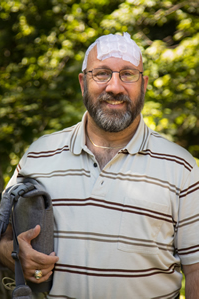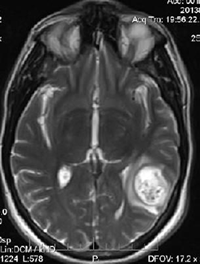The fourth weapon in the battle against cancer
It’s a sad truth that there are few people who haven’t been impacted by cancer in its various forms. However, a pioneering therapy that has been developed by oncology company Novocure, has tipped the scales in the fight against brain tumours. Electronic Specifier Editor Joe Bush finds out more and talks to a cancer survivor who has benefited from Tumor Treating Fields, or TTFields therapy.
Headquartered in Portsmouth, New Hampshire, Novocure is pushing the boundaries of cancer care via its Tumor Treating Fields, or TTFields therapy, which was discovered by company founder, Yoram Palti, MD, PhD, an expert in electrophysiology and biophysics, in the late 1990s - setting up a research laboratory into the benefits of electrical fields as a cancer treatment in his own basement. TTFields therapy basically involves electrodes, resembling a kind of ‘electric hat’, that are placed onto the patient’s shaved scalp. The device then generates electromagnetic waves between 100-300kHz to treat cancerous tumours.
The original three-strong research team expanded over the initial few years and in 2004, after successful first-in-human experiments for skin melanoma and breast metastases, a Phase II trial for glioblastoma opened in Prague, Czech Republic. Glioblastoma (GBM) is the most common and deadliest form of malignant brain cancer. Expected survival from initial diagnosis is 15 months, and survival from the time a tumour recurs after initial treatment is as little as three months, without additional treatment.
Three years later preclinical and clinical research, ‘Alternating Electric Fields Arrest Cell Proliferation in Animal Tumor Models and Human Brain Tumors’, concluded that TTFields are a safe and effective new treatment modality which slows down tumour growth in vitro (studies performed with microorganisms, cells or biological molecules outside their normal biological context - colloquially called ‘test-tube experiments’), in vivo (studies in which the effects of various biological entities are tested on whole, living organisms), and in human cancer patients.

Two years later the FDA approved the NovoTTF-100A System for treatment of adult patients (22 years or older), with recurrent glioblastoma. In 2014 the Optune, the brand name for the NovoTTF-100A system, was launched. Commercial launch of TTFields in Europe and Israel followed and currently, physicians at 15 leading brain cancer centres in eight countries are certified to provide NovoTTF Therapy to recurrent glioblastoma patients on prescription order.
Commenting on TTField therapy Bill Doyle (pictured below), Chairman of the Medical Devices Research and Development Council said: “Once our lives are touched by cancer we quickly learn that there are basically three weapons that are available to fight the disease – surgery, radiation and chemotherapy. And once we get involved in those therapeutic decisions, either personally or with our loved ones, we also very quickly learn about the benefits, the trade-offs and the limitations of these tools. However, now there is a fourth tool and it’s called TTFields.
“TTFields are non-invasive and are attached to the skin in the area of the tumour, and are applied very much like bandages, which the patient will ultimately be able to do themselves. Then the patient can carry on all of the activities of their daily life - there’s none of the tiredness, what’s called the chemo-head, there’s no sensation, it doesn’t interfere with computers or electrical equipment and the therapy is delivered continuously at home without having to go to the hospital either periodically or continually.
“What was seen in the trials was that patients that were subjected to TTField therapy suffered none of the side effects typical of chemotherapy patients – no pain, none of the infections, no nausea, diarrhoea, constipation or fatigue that would be expected.”
So, how does it work?
TTFields are low intensity, alternating electric fields within the intermediate frequency range. This non-invasive treatment targets solid tumours and they are generated by a pair of transducer arrays placed directly onto the skin’s surface. They disrupt cell division through physical interactions with key molecules during mitosis (the cell cycle in which chromosomes in a cell nucleus are separated into two identical sets of chromosomes). There are two well established physical processes that TTFields use to disrupt dividing cells. The first is dipole alignment. Dipoles are molecules in which the electric charge is separated. In a uniform alternating electric field dipoles oscillate in synchronisation with the field. At high frequencies motion diminishes as dipoles align with the field. The second is dielectrophoresis which occurs when electric fields are non-uniform, and as a result polarisable objects migrate towards regions of high field density.
In a biological context, during the metaphase stage of cell division, cells take on a rounded shape as the mitotic spindle forms. The spindle fibres, or microtubules, are created through the polymerisation of tubulin dimers which exhibit large dipole moments. When TTFields are activated a uniform electric field develops within the cell and dipole molecules are subject to rotational forces. This causes tubulin dimers to align with the field, inhibiting microtubule formation, leading to metaphase arrest, prolonged mitosis and cell death.
Deformed spindle fibres resulting from TTFields can also lead to abnormal DNA segregated between daughter cells and eventually cell death. In cells that manage to complete metaphase and enter cytokinesis, the hour glass shape that forms leads to a non-uniform electric field within the cell, this results in dielectrophoresis – net forces on polarisable objects towards regions of high field density, concentrating macro-molecules and organelles towards the mitotic furrow, leading to structural disruption and cell fragmentation.
The extent of electrical non-uniformity in dividing cells is dependent on the frequency of the TTFields, the electric properties of the cell and the orientation of the dividing cell relative to the field. Because cells divide in all directions, TTFields are delivered through two pairs of transducer arrays that generate perpendicular fields within the treated tumour. Cycling the field between these two directions ensures that a maximum range of cell orientations is targeted. Optimal tuning of field frequency to specific cell type further increases electrical non-uniformity, maximising TTFields’ anti-mitotic effect, without affecting non-dividing cells. TTFields exhibit a low toxicity profile due to their regional mode of delivery and frequency specific treatment of cancerous cells.
A story of hope
Robert DeRobertis (below), an engineer and father of two living near Boston, was diagnosed with GBM three years ago. He told Electronic Specifier his story and his experience of TTFields therapy.
 “‘You have cancer’. The three words you don’t ever want to hear. The truth is I was never actually told I have cancer, I was told I have Glioblastoma Multiforme grade 4 (GBM). From my research on the web, (which all cancer patients are told not to do), I learnt that the survival rate is 12-15 months with less than five percent surviving greater than five years.
“‘You have cancer’. The three words you don’t ever want to hear. The truth is I was never actually told I have cancer, I was told I have Glioblastoma Multiforme grade 4 (GBM). From my research on the web, (which all cancer patients are told not to do), I learnt that the survival rate is 12-15 months with less than five percent surviving greater than five years.
“It will be three years this October that I was told of my diagnosis and prognosis. It started the day after Labor Day 2013. I was driving home from work on the outskirts of Boston, listening to my favourite podcast on photography. Then suddenly I realised I did not know what the speaker was talking about, which was strange as I’d been a competitive photographer for around five years. I turned off the podcast and looked out the window.
“I realised I couldn’t read the road signs. I saw the words clearly, I just didn’t know what they meant. Being an engineer, I wanted to analyse and understand what wasn’t working inside my head. I could count and say the alphabet, but I couldn’t remember short term items. For example, I knew my family members’ names but not the name of my son’s girlfriend.
“Miraculously I was still able to drive home – I just couldn’t read the signs along the way. I think a normal person would write this off as having a ‘senior moment’ - after all I had just turned 51. That evening sitting on the sofa watching TV, I decided to tell my wife what happened. She asked if I was going to see the doctor - I decided that I would make the appointment. And it was a good thing as GBM grow very quickly and waiting is never a good idea.
“I consider myself very lucky. When discovered, the tumour was 3.2x2.4cm. I understand this was relatively small. I am fortunate to live near Boston with some of the best doctors in the country around the hubs of Dana Farber and Harvard Medical Center. At this point in time I was not choosy on who would be my surgeon. I was fortunate to have Dr. Brian Nahed at Mass General who removed 99.6% of the tumour. Afterwards I found that I could read and write again and four months later I was back to working full time. I went through chemotherapy and radiation therapy, the standard care which is found to extend one’s life by a year before most likely I would be dealing with a recurrence.
“In the process a friend introduced me to Dr. Eric Wong at Beth Israel Medical Center in Boston. Dr. Wong was the original sponsor of the Novocure device. Through him I went through chemotherapy, radiation and then onto the Novocure study. Dr. Wong recommended a new experimental treatment that uses AC signals to create a resonance frequency, with no chemicals involved. It required keeping my head shaved and gluing on the arrays that deliver the AC signal into the area where the tumour was located.

“I originally thought he was crazy. But I did my research and I decided to be part of the study. Wearing this device is certainly a lifestyle change, but having cancer is the real life changer. Three years later, I am cancer-free, healthy and living a normal life. The study results show a much higher survival rate and I was told by Dr. Wong that for the first time studying GBM, there are statistics showing significant long term survival rates.
“The more you use the device the better the expected results. I try to keep the device running 85% of the time, so I wear it almost constantly, even when I sleep. I need to change the arrays twice a week and to do this I need to shave my head to keep the arrays as close to my scalp as possible. They suggest not having gaps longer than three hours for effective results.
“They just released a newer lighter device with much smaller batteries than the device used in the study. Being in the business of electronics, I knew it would only be a matter of time when Moore’s law would take effect.
“After 25 monthly MRIs to monitor my health, two months ago the doctors said they would like to see less of me. I did not take it personally - it’s good when an oncologist and brain surgeon gets bored with you.”










